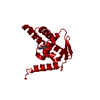+ Open data
Open data
- Basic information
Basic information
| Entry | Database: PDB / ID: 6xmx | |||||||||||||||
|---|---|---|---|---|---|---|---|---|---|---|---|---|---|---|---|---|
| Title | Cryo-EM structure of BCL6 bound to BI-3802 | |||||||||||||||
 Components Components | B-cell lymphoma 6 protein | |||||||||||||||
 Keywords Keywords | TRANSCRIPTION / transcription factor / degrader | |||||||||||||||
| Function / homology |  Function and homology information Function and homology informationregulation of memory T cell differentiation / negative regulation of mitotic cell cycle DNA replication / intronic transcription regulatory region sequence-specific DNA binding / negative regulation of plasma cell differentiation / negative regulation of T-helper 2 cell differentiation / negative regulation of isotype switching to IgE isotypes / isotype switching to IgE isotypes / negative regulation of mast cell cytokine production / regulation of germinal center formation / negative regulation of mononuclear cell proliferation ...regulation of memory T cell differentiation / negative regulation of mitotic cell cycle DNA replication / intronic transcription regulatory region sequence-specific DNA binding / negative regulation of plasma cell differentiation / negative regulation of T-helper 2 cell differentiation / negative regulation of isotype switching to IgE isotypes / isotype switching to IgE isotypes / negative regulation of mast cell cytokine production / regulation of germinal center formation / negative regulation of mononuclear cell proliferation / plasma cell differentiation / paraspeckles / germinal center formation / regulation of immune system process / pyramidal neuron differentiation / type 2 immune response / T-helper 2 cell differentiation / positive regulation of regulatory T cell differentiation / positive regulation of cell motility / negative regulation of B cell apoptotic process / negative regulation of Rho protein signal transduction / erythrocyte development / FOXO-mediated transcription of cell death genes / regulation of cell differentiation / TP53 regulates transcription of several additional cell death genes whose specific roles in p53-dependent apoptosis remain uncertain / regulation of T cell proliferation / B cell proliferation / negative regulation of cellular senescence / negative regulation of cell-matrix adhesion / negative regulation of Notch signaling pathway / regulation of immune response / Rho protein signal transduction / positive regulation of B cell proliferation / positive regulation of neuron differentiation / regulation of cytokine production / cell-matrix adhesion / transcription corepressor binding / cell motility / negative regulation of cell growth / chromatin DNA binding / DNA-binding transcription repressor activity, RNA polymerase II-specific / cell morphogenesis / sequence-specific double-stranded DNA binding / intracellular protein localization / heterochromatin formation / regulation of cell population proliferation / regulation of inflammatory response / actin cytoskeleton organization / Interleukin-4 and Interleukin-13 signaling / spermatogenesis / DNA-binding transcription factor binding / sequence-specific DNA binding / transcription by RNA polymerase II / positive regulation of apoptotic process / RNA polymerase II cis-regulatory region sequence-specific DNA binding / DNA-binding transcription factor activity / inflammatory response / negative regulation of DNA-templated transcription / DNA damage response / chromatin binding / nucleolus / negative regulation of transcription by RNA polymerase II / Golgi apparatus / zinc ion binding / nucleoplasm / identical protein binding / nucleus Similarity search - Function | |||||||||||||||
| Biological species |  Homo sapiens (human) Homo sapiens (human) | |||||||||||||||
| Method | ELECTRON MICROSCOPY / single particle reconstruction / cryo EM / Resolution: 3.7 Å | |||||||||||||||
 Authors Authors | Yoon, H. / Burman, S.S.R. / Hunkeler, M. / Nowak, R.P. / Fischer, E.S. | |||||||||||||||
| Funding support |  United States, United States,  Switzerland, 4items Switzerland, 4items
| |||||||||||||||
 Citation Citation |  Journal: Nature / Year: 2020 Journal: Nature / Year: 2020Title: Small-molecule-induced polymerization triggers degradation of BCL6. Authors: Mikołaj Słabicki / Hojong Yoon / Jonas Koeppel / Lena Nitsch / Shourya S Roy Burman / Cristina Di Genua / Katherine A Donovan / Adam S Sperling / Moritz Hunkeler / Jonathan M Tsai / Rohan ...Authors: Mikołaj Słabicki / Hojong Yoon / Jonas Koeppel / Lena Nitsch / Shourya S Roy Burman / Cristina Di Genua / Katherine A Donovan / Adam S Sperling / Moritz Hunkeler / Jonathan M Tsai / Rohan Sharma / Andrew Guirguis / Charles Zou / Priya Chudasama / Jessica A Gasser / Peter G Miller / Claudia Scholl / Stefan Fröhling / Radosław P Nowak / Eric S Fischer / Benjamin L Ebert /   Abstract: Effective and sustained inhibition of non-enzymatic oncogenic driver proteins is a major pharmacological challenge. The clinical success of thalidomide analogues demonstrates the therapeutic efficacy ...Effective and sustained inhibition of non-enzymatic oncogenic driver proteins is a major pharmacological challenge. The clinical success of thalidomide analogues demonstrates the therapeutic efficacy of drug-induced degradation of transcription factors and other cancer targets, but a substantial subset of proteins are resistant to targeted degradation using existing approaches. Here we report an alternative mechanism of targeted protein degradation, in which a small molecule induces the highly specific, reversible polymerization of a target protein, followed by its sequestration into cellular foci and subsequent degradation. BI-3802 is a small molecule that binds to the Broad-complex, Tramtrack and Bric-à-brac (BTB) domain of the oncogenic transcription factor B cell lymphoma 6 (BCL6) and leads to the proteasomal degradation of BCL6. We use cryo-electron microscopy to reveal how the solvent-exposed moiety of a BCL6-binding molecule contributes to a composite ligand-protein surface that engages BCL6 homodimers to form a supramolecular structure. Drug-induced formation of BCL6 filaments facilitates ubiquitination by the SIAH1 E3 ubiquitin ligase. Our findings demonstrate that a small molecule such as BI-3802 can induce polymerization coupled to highly specific protein degradation, which in the case of BCL6 leads to increased pharmacological activity compared to the effects induced by other BCL6 inhibitors. These findings open new avenues for the development of therapeutic agents and synthetic biology. | |||||||||||||||
| History |
|
- Structure visualization
Structure visualization
| Movie |
 Movie viewer Movie viewer |
|---|---|
| Structure viewer | Molecule:  Molmil Molmil Jmol/JSmol Jmol/JSmol |
- Downloads & links
Downloads & links
- Download
Download
| PDBx/mmCIF format |  6xmx.cif.gz 6xmx.cif.gz | 377.5 KB | Display |  PDBx/mmCIF format PDBx/mmCIF format |
|---|---|---|---|---|
| PDB format |  pdb6xmx.ent.gz pdb6xmx.ent.gz | 291.7 KB | Display |  PDB format PDB format |
| PDBx/mmJSON format |  6xmx.json.gz 6xmx.json.gz | Tree view |  PDBx/mmJSON format PDBx/mmJSON format | |
| Others |  Other downloads Other downloads |
-Validation report
| Summary document |  6xmx_validation.pdf.gz 6xmx_validation.pdf.gz | 1.6 MB | Display |  wwPDB validaton report wwPDB validaton report |
|---|---|---|---|---|
| Full document |  6xmx_full_validation.pdf.gz 6xmx_full_validation.pdf.gz | 1.7 MB | Display | |
| Data in XML |  6xmx_validation.xml.gz 6xmx_validation.xml.gz | 43.8 KB | Display | |
| Data in CIF |  6xmx_validation.cif.gz 6xmx_validation.cif.gz | 58.4 KB | Display | |
| Arichive directory |  https://data.pdbj.org/pub/pdb/validation_reports/xm/6xmx https://data.pdbj.org/pub/pdb/validation_reports/xm/6xmx ftp://data.pdbj.org/pub/pdb/validation_reports/xm/6xmx ftp://data.pdbj.org/pub/pdb/validation_reports/xm/6xmx | HTTPS FTP |
-Related structure data
| Related structure data |  22265MC M: map data used to model this data C: citing same article ( |
|---|---|
| Similar structure data |
- Links
Links
- Assembly
Assembly
| Deposited unit | 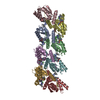
|
|---|---|
| 1 |
|
- Components
Components
| #1: Protein | Mass: 44505.305 Da / Num. of mol.: 8 / Mutation: R160C Source method: isolated from a genetically manipulated source Source: (gene. exp.)  Homo sapiens (human) / Gene: BCL6, BCL5, LAZ3, ZBTB27, ZNF51 / Plasmid: pAC-derived / Production host: Homo sapiens (human) / Gene: BCL6, BCL5, LAZ3, ZBTB27, ZNF51 / Plasmid: pAC-derived / Production host:  Trichoplusia ni (cabbage looper) / References: UniProt: P41182 Trichoplusia ni (cabbage looper) / References: UniProt: P41182#2: Chemical | ChemComp-U52 / Has ligand of interest | Y | |
|---|
-Experimental details
-Experiment
| Experiment | Method: ELECTRON MICROSCOPY |
|---|---|
| EM experiment | Aggregation state: FILAMENT / 3D reconstruction method: single particle reconstruction |
- Sample preparation
Sample preparation
| Component | Name: B-cell lymphoma 6 protein (BCL6) filament / Type: ORGANELLE OR CELLULAR COMPONENT Details: BCL6 polymerized upon addition of small molecule BI-3802. 4 dimers enclosed in map. Entity ID: #1 / Source: RECOMBINANT | ||||||||||||||||||||
|---|---|---|---|---|---|---|---|---|---|---|---|---|---|---|---|---|---|---|---|---|---|
| Molecular weight | Value: 0.352 MDa / Experimental value: NO | ||||||||||||||||||||
| Source (natural) | Organism:  Homo sapiens (human) Homo sapiens (human) | ||||||||||||||||||||
| Source (recombinant) | Organism:  Trichoplusia ni (cabbage looper) Trichoplusia ni (cabbage looper) | ||||||||||||||||||||
| Buffer solution | pH: 7.4 | ||||||||||||||||||||
| Buffer component |
| ||||||||||||||||||||
| Specimen | Conc.: 0.48 mg/ml / Embedding applied: NO / Shadowing applied: NO / Staining applied: NO / Vitrification applied: YES Details: Strep II-Avi BCL6 (aa5-360) polymerized by addition of 1.5 molar excess BI-3802. CHAPSO (0.8 mM final) added for grid preparation. | ||||||||||||||||||||
| Specimen support | Grid material: COPPER / Grid mesh size: 300 divisions/in. / Grid type: Quantifoil R1.2/1.3 | ||||||||||||||||||||
| Vitrification | Instrument: LEICA EM GP / Cryogen name: ETHANE / Humidity: 95 % / Chamber temperature: 283.15 K / Details: 4 ul sample applied twice, blotted 1.3s each time |
- Electron microscopy imaging
Electron microscopy imaging
| Experimental equipment |  Model: Titan Krios / Image courtesy: FEI Company |
|---|---|
| Microscopy | Model: FEI TITAN KRIOS Details: Data collection in counting mode, using multi shot scheme (4 holes per stage position, 2 shots per hole) |
| Electron gun | Electron source:  FIELD EMISSION GUN / Accelerating voltage: 300 kV / Illumination mode: FLOOD BEAM FIELD EMISSION GUN / Accelerating voltage: 300 kV / Illumination mode: FLOOD BEAM |
| Electron lens | Mode: BRIGHT FIELD / Nominal magnification: 105000 X / Nominal defocus max: -2500 nm / Nominal defocus min: -1000 nm / Cs: 2.7 mm / C2 aperture diameter: 50 µm / Alignment procedure: COMA FREE |
| Specimen holder | Cryogen: NITROGEN / Specimen holder model: FEI TITAN KRIOS AUTOGRID HOLDER |
| Image recording | Average exposure time: 3 sec. / Electron dose: 63.4 e/Å2 / Film or detector model: GATAN K3 BIOQUANTUM (6k x 4k) / Num. of grids imaged: 1 / Num. of real images: 7553 |
| EM imaging optics | Energyfilter name: GIF Bioquantum / Energyfilter slit width: 20 eV |
| Image scans | Width: 5760 / Height: 4092 |
- Processing
Processing
| Software |
| ||||||||||||||||||||||||||||||||||||||||||||
|---|---|---|---|---|---|---|---|---|---|---|---|---|---|---|---|---|---|---|---|---|---|---|---|---|---|---|---|---|---|---|---|---|---|---|---|---|---|---|---|---|---|---|---|---|---|
| EM software |
| ||||||||||||||||||||||||||||||||||||||||||||
| Image processing | Details: The selected movies were corrected for beam-induced motion. | ||||||||||||||||||||||||||||||||||||||||||||
| CTF correction | Details: Standard CTF correction in relion, based on parameters estimated by CTFFIND4 Type: PHASE FLIPPING AND AMPLITUDE CORRECTION | ||||||||||||||||||||||||||||||||||||||||||||
| Particle selection | Num. of particles selected: 1610413 / Details: particles picked with crYOLO | ||||||||||||||||||||||||||||||||||||||||||||
| Symmetry | Point symmetry: C1 (asymmetric) | ||||||||||||||||||||||||||||||||||||||||||||
| 3D reconstruction | Resolution: 3.7 Å / Resolution method: FSC 0.143 CUT-OFF / Num. of particles: 112048 / Details: as implemented in Relion / Num. of class averages: 1 / Symmetry type: POINT | ||||||||||||||||||||||||||||||||||||||||||||
| Atomic model building | Protocol: RIGID BODY FIT / Space: REAL Details: Real_space_refine: global minimization, rigid body and adp refinement with target restraints. | ||||||||||||||||||||||||||||||||||||||||||||
| Atomic model building | PDB-ID: 5MW2 Pdb chain-ID: A / Accession code: 5MW2 / Pdb chain residue range: 7-128 / Source name: PDB / Type: experimental model | ||||||||||||||||||||||||||||||||||||||||||||
| Refinement | Cross valid method: NONE Stereochemistry target values: GeoStd + Monomer Library + CDL v1.2 | ||||||||||||||||||||||||||||||||||||||||||||
| Displacement parameters | Biso mean: 23.38 Å2 | ||||||||||||||||||||||||||||||||||||||||||||
| Refine LS restraints |
|
 Movie
Movie Controller
Controller




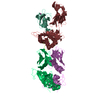
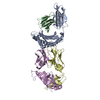
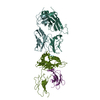
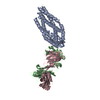
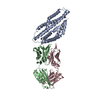
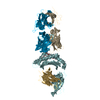
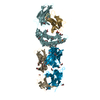


 PDBj
PDBj














